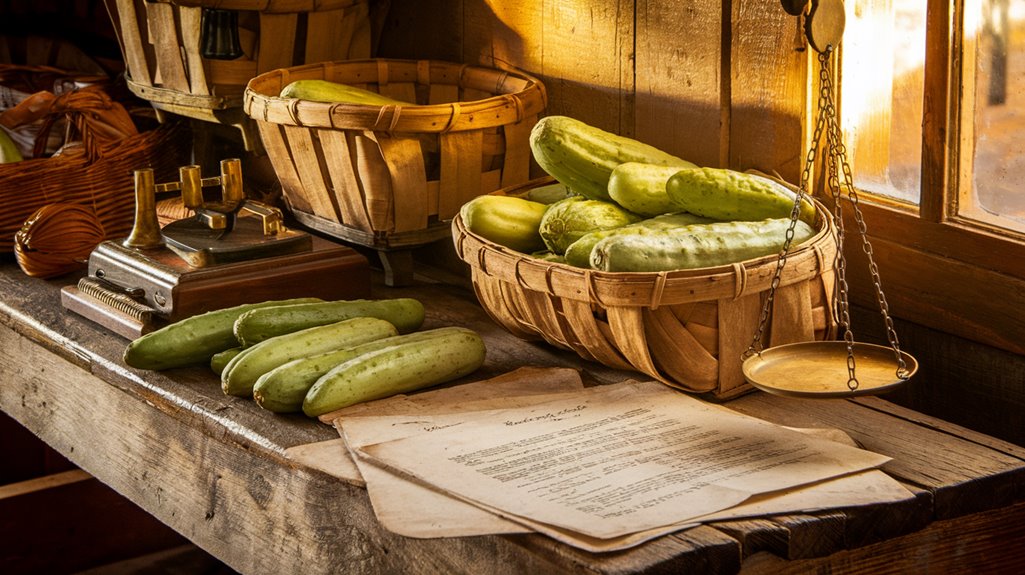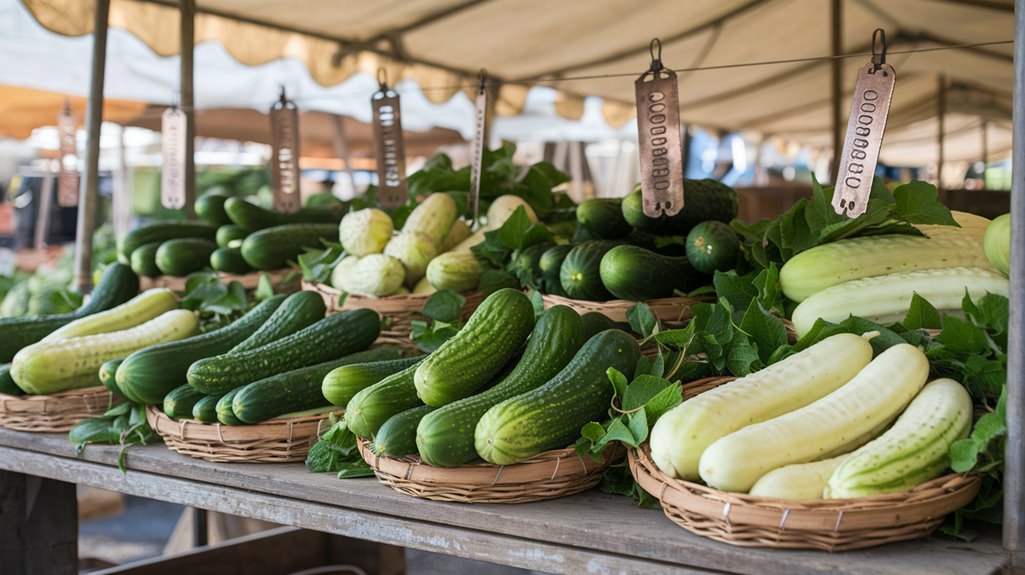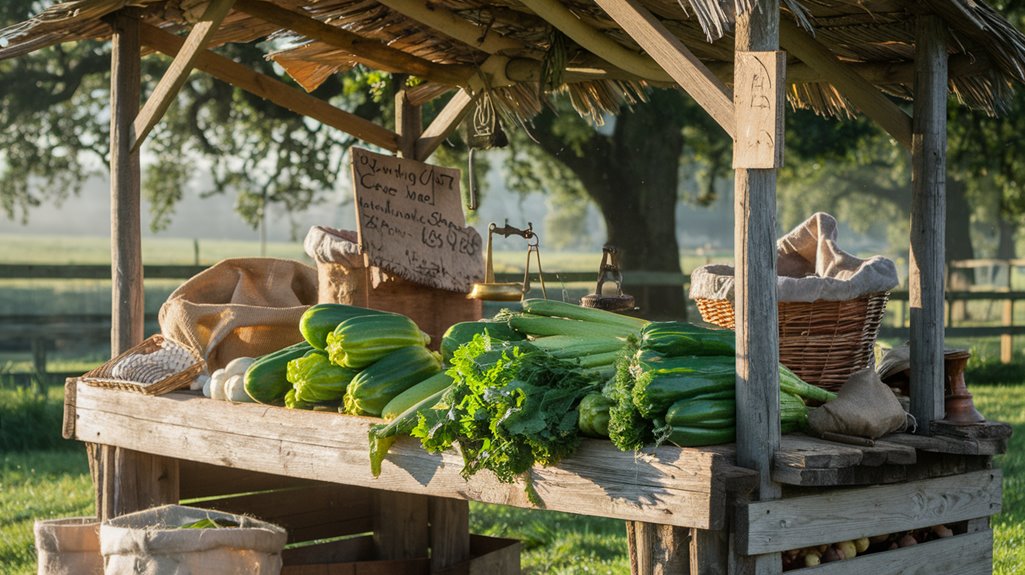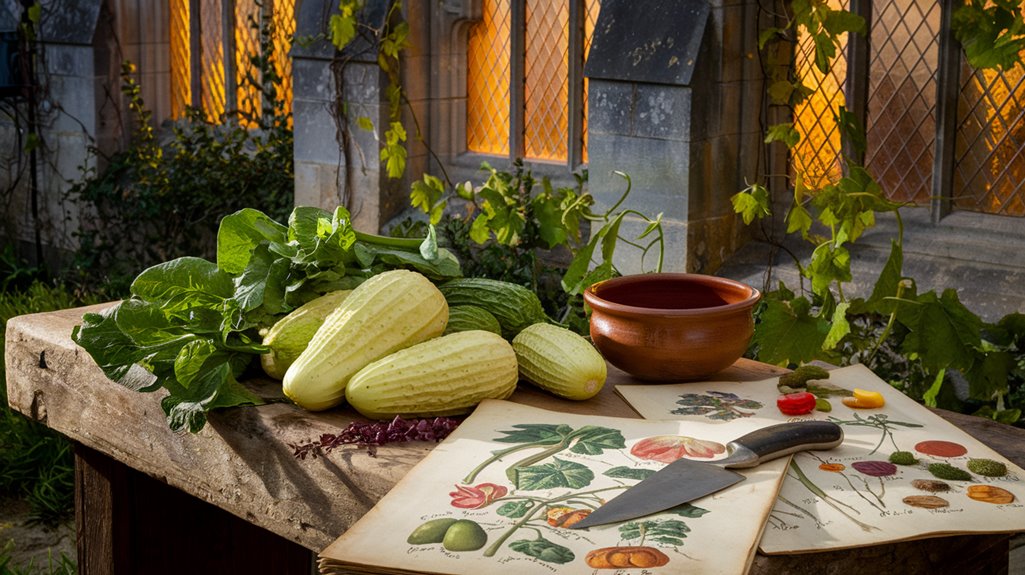Cucumbers Were Previously Called Cowcumbers
You might think you know your vegetables, but the humble cucumber has a surprisingly class-conscious past. In 19th century England, your pronunciation of this crisp, green vegetable could instantly reveal your social standing. The term "cowcumber" wasn't just a casual mispronunciation—it marked you as part of the lower class, while "cucumber" signaled refinement and education. This linguistic divide persisted well into the 1930s, and there's more to this vegetable's social history than meets the eye.
The Evolution of the Word Cucumber Through History

While many English words have evolved over time, the term "cucumber" has taken a particularly interesting journey through linguistic history.
The cucumber etymology starts with the Latin "cucumis, cucumerem," which likely originated from a pre-Italic Mediterranean language. You'll find that this word transformed into the Old French "cocombre" before making its way into English. This transformation reflects how most English words have origins in Latin or Greek.
In the linguistic evolution of this term, you can trace how it replaced the Old English "eorþæppla" (meaning earth-apples) and became "cucomer" in the late 14th century.
By the 17th and 18th centuries, English speakers commonly used the term "cowcumber", which later came to be associated with ignorance and old-fashioned speech by the 1830s.
Social Class and the Term "Cowcumber"
Beyond its role as a simple vegetable name, the term "cowcumber" became a powerful social class marker in 19th century England. You'll find this linguistic heritage reflected in literature, where authors like Charles Dickens used the pronunciation to highlight social differences. The term carried a social stigma that lasted well into the 20th century. This humble vegetable has ancient Asian roots, having been first cultivated in western Asia over 3,000 years ago.
- The "proper" pronunciation of cucumber indicated higher social standing
- Lower classes commonly used "cowcumber" until the 1930s
- The term was officially listed as a "vulgar corruption" in 1890
- Literary works used it to mock lower-class characters
- Education levels influenced the shift to "cucumber"
Even in America, this class distinction persisted, with "cowcumber" remaining common in certain regions until the 1960s, showcasing how deeply embedded these social markers were in everyday speech. The word originated from the Old French cocombre, which eventually made its way into the English language through biblical translations.
Medieval Beliefs About Cucumber Consumption
The evolution of cucumber terminology parallels fascinating medieval beliefs about this versatile vegetable's consumption and powers. You'd find cucumbers playing multiple roles in medieval society, from healing remedies to spiritual protection. The Romans, who cherished this vegetable, ensured its availability by developing artificial growing techniques.
Medieval remedies often included cucumbers to treat various ailments, from headaches to scorpion bites, and they were particularly valued for their cooling properties during hot weather.
Cucumber symbolism was deeply rooted in medieval cultural beliefs. You might've seen them hanging in doorways to ward off evil spirits or placed under beds for protection. The upper class considered cucumbers particularly special, as they were often a luxury item due to cultivation difficulties in Europe's climate.
They were especially significant in wedding ceremonies, representing fertility and prosperity. In monastery gardens, monks cultivated cucumbers for both their culinary and medicinal properties, often preserving them through pickling to guarantee year-round availability.
Ancient Roman Cultivation Techniques
Since Emperor Tiberius demanded fresh cucumbers daily, Roman gardeners developed remarkably innovative cultivation techniques that revolutionized ancient horticulture.
These horticultural advancements included the use of wheeled beds and transparent stone coverings to control growing conditions year-round.
Roman gardening practices were so sophisticated that they created early versions of modern greenhouses. The methods they developed were extensively documented in their pickling practices for preserving cucumbers.
You'll be amazed by their key innovations:
- Portable containers that could be moved to optimize growing conditions
- Proto-greenhouses with translucent stone panes
- Temperature-controlled buildings for winter cultivation
- Mobile wheeled beds to follow sunlight patterns
- Advanced irrigation and soil management systems
These techniques spread throughout Europe, influencing agriculture for centuries to come.
You can find detailed accounts of these methods in ancient texts like "De Re Rustica" and "Historia Naturalis."
The Romans' innovative growing methods were particularly important since cucumbers had already been grown for 3000 years as a valuable food source before reaching their civilization.
The Global Journey of Cucumber Varieties

Originally cultivated in China and Nepal over three millennia ago, cucumbers commenced on a remarkable journey that transformed them into a global agricultural powerhouse.
Today, you'll find distinct cucumber types flourishing across different regions, each adapted to local tastes and culinary traditions. The cucumber breeding process requires at least seven years before new varieties can reach supermarket shelves.
You'll notice how global preferences shape cultivation choices: Chinese and Japanese markets favor prickly varieties for stir-frying, while Russians embrace both raw and pickled forms.
Modern breeding companies like Rijk Zwaan and Enza Zaden spend years developing varieties that cater to these diverse needs. They're focusing on everything from Turkey's light-colored snacking cucumbers to America's popular mini varieties. Similar to how narrative research methods reveal unique cultural experiences, these breeding developments tell the story of regional agricultural adaptations.
The journey continues as breeders work to enhance taste, shelf life, and sustainability, while adapting to changing consumer demands and climate challenges.










